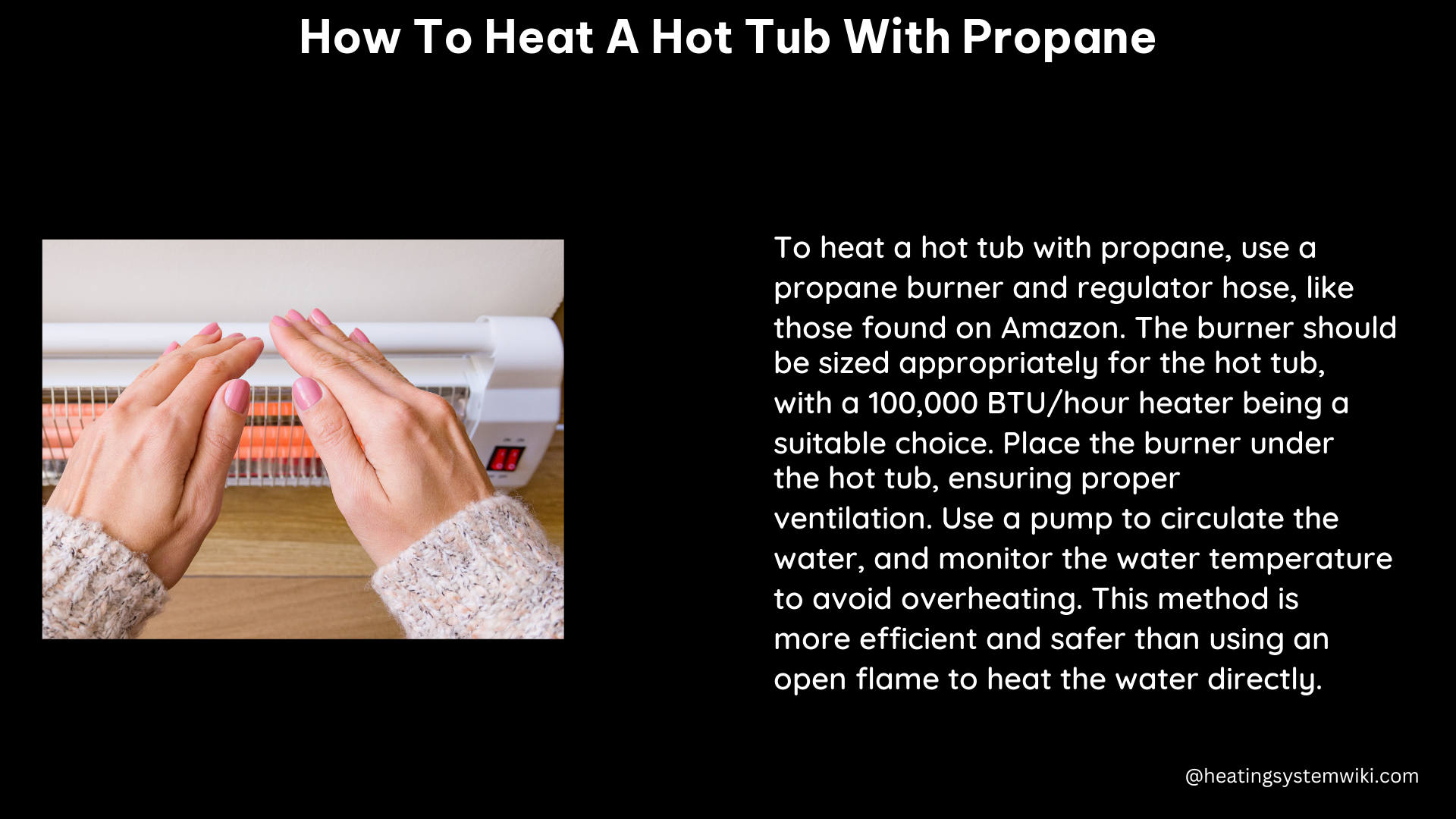Heating a hot tub with propane is a cost-effective and efficient way to enjoy the soothing warmth of a relaxing soak, especially in areas where electricity may be scarce or unreliable. This comprehensive guide will walk you through the step-by-step process of setting up a propane-powered hot tub heating system, complete with technical specifications, DIY resources, and expert tips to ensure a successful and safe installation.
Choosing the Right Propane Heater
The first step in heating your hot tub with propane is selecting the appropriate heater. The size of your hot tub will determine the BTU (British Thermal Unit) rating you’ll need for your propane heater. As a general rule, a 100,000 BTU heater is sufficient for most standard-sized hot tubs, typically ranging from 300 to 500 gallons in capacity.
When choosing a propane heater, it’s crucial to select one that is designed for outdoor use and meets all necessary safety standards. Look for features such as automatic shut-off valves, overheat protection, and proper ventilation to ensure the safe operation of your propane heating system.
Installing the Propane Heater

Once you’ve selected the right propane heater, it’s time to install it according to the manufacturer’s instructions. This process typically involves the following steps:
-
Connecting the Heater to the Propane Tank: Securely connect the propane heater to a suitable propane tank, ensuring a tight and leak-free connection. Use the appropriate fittings and hoses recommended by the manufacturer.
-
Installing the Vent: Properly install the vent for the propane heater to allow for adequate airflow and prevent the buildup of harmful exhaust gases. Ensure the vent is positioned in a way that complies with local building codes and safety regulations.
-
Providing a Stable Base: Create a stable and level foundation for the propane heater, such as a concrete pad or a sturdy metal frame. This will ensure the heater remains secure and level during operation.
-
Securing the Heater: Firmly secure the propane heater to the base, using the appropriate mounting hardware and techniques recommended by the manufacturer. This will prevent the heater from shifting or tipping over during use.
Installing the Water Circulation Pump
To effectively heat the water in your hot tub, you’ll need to install a pump to circulate the water through the propane heater. This can be either a submersible pump or an external pump, depending on your hot tub’s design and layout.
When selecting a pump, ensure it is rated for use with hot tubs and has the necessary safety features, such as overload protection and thermal cutoff switches. The pump should be capable of circulating the water at a rate that is compatible with the size of your hot tub and the BTU output of the propane heater.
Plumbing the Heating System
Connecting the pump to the hot tub and the propane heater is the next step in the process. This typically involves using PVC pipe and fittings to create a closed-loop system that allows the water to flow from the hot tub, through the heater, and back into the hot tub.
When plumbing the system, pay close attention to the following:
- Pipe Size: Use the appropriate pipe size (typically 1.5 or 2 inches in diameter) to ensure efficient water flow and minimize pressure drops.
- Fittings and Adhesives: Select high-quality fittings and use the correct adhesives to create secure, leak-free connections.
- Insulation: Consider insulating the plumbing to minimize heat loss and improve the system’s efficiency.
- Accessibility: Position the plumbing in a way that allows for easy access and maintenance, if necessary.
Installing the Thermostat
To automatically control the temperature of your hot tub, you’ll need to install a thermostat. This can be a standalone unit or one that is integrated into the propane heater or the water circulation pump.
When installing the thermostat, ensure it is rated for use with hot tubs and can withstand the high temperatures and humidity associated with this environment. The thermostat should be placed in a location that allows for easy access and monitoring, such as near the hot tub or the control panel.
Testing and Troubleshooting the System
Once you’ve completed the installation, it’s time to test the system and ensure it’s functioning correctly. Fill the hot tub with water, turn on the pump, and set the thermostat to your desired temperature. Monitor the water temperature closely and make any necessary adjustments to the system.
If you encounter any issues during the testing phase, refer to the manufacturer’s troubleshooting guide or consult with a professional for assistance. Common problems may include:
- Insufficient Heating: Ensure the propane heater is the correct size for your hot tub and that the water is circulating properly.
- Leaks: Check all plumbing connections for any signs of leaks and make necessary repairs.
- Thermostat Malfunctions: Verify the thermostat is functioning correctly and replace it if necessary.
By following this comprehensive guide and addressing any issues that arise, you’ll be well on your way to enjoying the soothing warmth of a propane-heated hot tub in no time.
Resources and References
Here are some additional resources and references to help you with your propane hot tub heating project:
Videos:
– Propane Hot Tub DIY – 100 Gallons of Bliss
– Redneck Hot Tub Engineering – Propane Conversion
Forum Posts:
– Add-On Propane Heater for a Swim Spa?
References:
– Propane Heater Sizing Guide
– Hot Tub Plumbing Best Practices
– Thermostat Installation Tips for Hot Tubs
